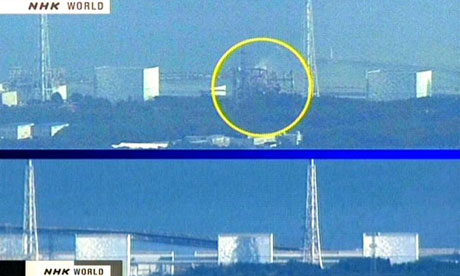400 millisievert
L'agenzia Kyodo annuncia la notizia di fughe radioattive dall'impianto di Fukushima Daiichi.
The government's Nuclear and Industrial Safety Agency said the explosion at the No 2 reactor may have damaged the "suppression chamber," a facility connected to the reactor's container which is designed to cool down radiation steam and lower the pressure in the reactor. It said a sharp decline in the pressure level of the chamber suggests damage.
Following the incident, the radiation level near the main gate of the Fukushima No. 1 plant exceeded the legal limit to reach 965.5 micro sievert per hour at 7:00 a.m. and jumped to 8,217 micro sievert at 8:31 a.m., the agency said. The latter amount is more than eight times the 1,000 micro sievert level to which people can safely be exposed in one year.Lo stato dei quattro reattori.
Reactor 1: Earlier Hydrogen explosion has blown off the top of the reactor building.
Reactor 2: Containment vessel possibly damaged in explosion, coolant pumps damaged by earlier explosions and valves closed, fuel rods exposed and may be leaking radioactive water from suppression pool.
Reactor 3: Earlier Hydrogen explosion, cloud of steam still rising, top half of reactor's building blown off.
Reactor 4: Fire broke out late Monday, probably caused by nearby explosions, now put out, spent nuclear fuel may have been exposed, destroying the reactor's housing. The fire may be the cause of the high levels of radiation at the site.L'atmosfera a Tokyo è pesante.
Il Nikkei sta evaporando. Le ambasciate invitano a lasciare il paese. Lunghe code in tutte le stazioni ferroviarie in cerca di treni che portino il più lontano possibile dalla città. Il megastore Don Chisciotte, a Rappongi, ha finito le scorte di radio, taniche di benzina, candele e sacchi a pelo.La dichiarazione del primo ministro Naoto Kan.
Radiation has spread from these reactors and the reading of the level seems very high, and there is still a very high risk of further radiactive material coming out.
From the Fukushima 1 power plant a 20km radius has become an area for evacuation. Most of the people have evacuated from this area, We need now for everybody to move out from the 20km radius from the No1 plant, and in areas from 20-30km from the power plant, depending on what happens at the power plant, we would like to ask you to remain indoors, at home or in your offices. We would like to ask you to remain indoors and avoid going outside.Credo sia importante sottolineare che a Fukushima Daiichi 50 persone stanno rischiando la vita per tenere sotto un qualche controllo la situazione.
[09:25] Il livello di radiazioni attorno alla centrale nucleare ha raggiunto i 400.000 microsieverts. Ad annunciarlo Yukio Edano.
[12:49] Il Guardian pubblica una tabella comparativa per comprendere il livello e la pericolosità delle radiazioni calcolato in sievert.
2 millisieverts/year: The level of natural background radiation we are all exposed to.
9 millisieverts/year: The typical dose received by an airline crew flying the New York to Tokyo polar route. Flying at altitude increases radiation exposure to cosmic rays.
100 millisieverts/year: The lowest level at which an increase in cancer is evident.
1.000 millisieverts accumulative: Estimated to cause a fatal cancer many years later in 5% of people.
1.000 millisieverts single dose: Temporary radiation sickness, including nausea, lower white blood cell count. Not fatal.
5.000 millisieverts single dose: Fatal within a month to half those who receive it.
10.000 millisieverts single dose: Fatal within weeks.

